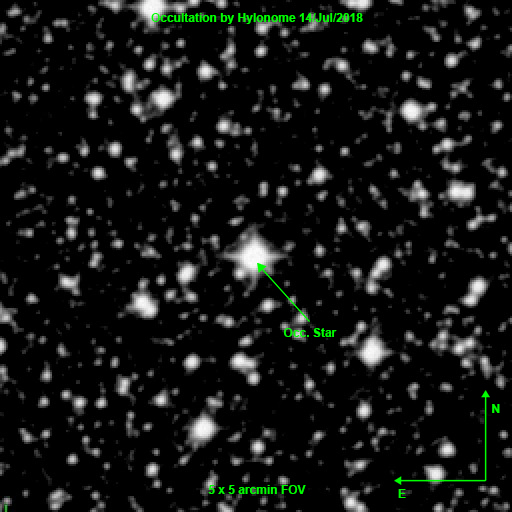Hylonome 14/07/2018
*Prediction based on Gaia DR2
Observation tips:
- Shadow moves from **East to West**;
- The nominal occultation time on the map, corresponds to the big red dot, the closest approach.
- Each red dot is separated by one minute;
- Dark gray is night and light gray is astronomical twilight (Sun at less than 18 deg below the horizon);
- *Absolute time accuracy is essential** (see important note below);
- Observations are requested from 15:51 to 15:56 Universal Time.
After the observation, please fill the form available on this link (form), and send it to ribas(at)on.br.
| Star J2000 coordinates: |
|
RA 18 36 55.468 DEC -18 55 10.421 |
| Day coordinates of the object: |
| RA 18 38 01.291 DEC -18 54 03.383 |
| Hylonome V mag | 22.4 |
| Star G mag | 10.0 |
| Star Rp mag | 9.7 |
| Star Bp mag | 10.2 |
| Star K mag | 9.2 |
| Magnitude drop in G | 12.4 |
| Maximum
duration |
3.5
sec |
| Moon
| 3.5% illum. |
@
145 deg |
Important note:
*Absolute time accuracy is essential**
to connect all the observations together after the fact. Check the time of your computer with many sources (phone talked hour, different internet sites, ideally with a GPS). Its advised to check the registered time right after and right before the integrations, so if there is a drift, we can correct it by having the difference.
Beware of the dead time between the images: if you manage an exposure time of 1 sec (for example), but have your camera takes 2 sec to read the image, then there is a 67% chance that you miss the dis(re)-appearance of the star. So it's better to have, for example, a 4 sec integration, so you have 67% chance to get the occultation in one of your exposures.
05
x 05
arcmin FOV (North
is up, East is left)

20 x 20 arcmin FOV (North is up, East is left)


20 x 20 arcmin FOV (North is up, East is left)

Please,
see the observation
tips at the top!